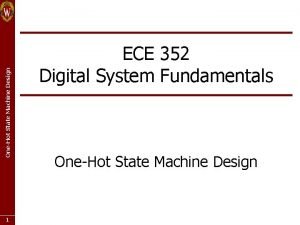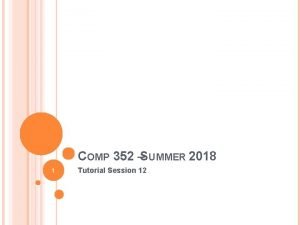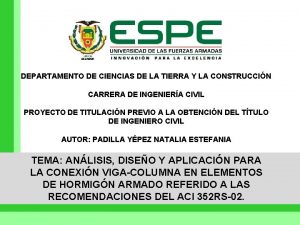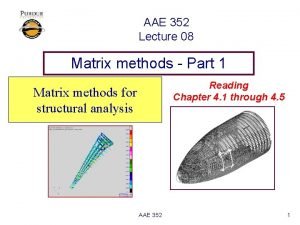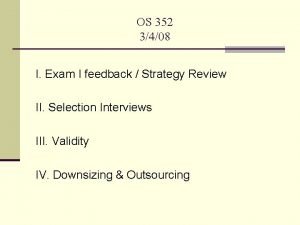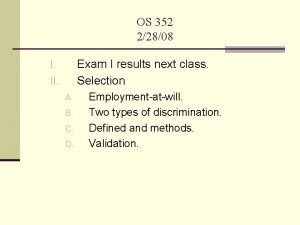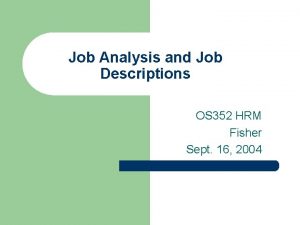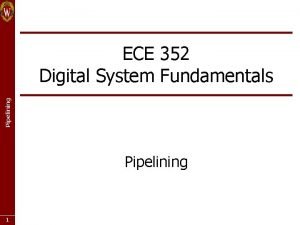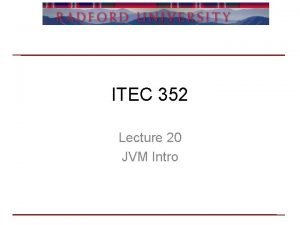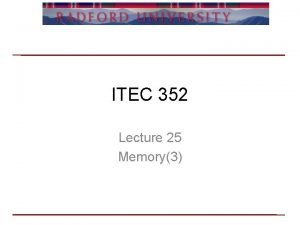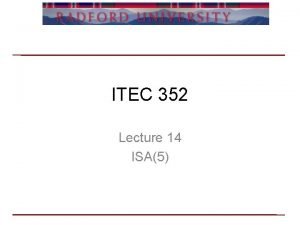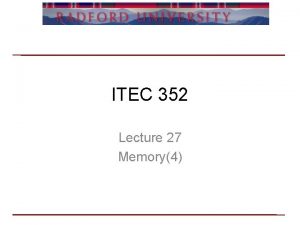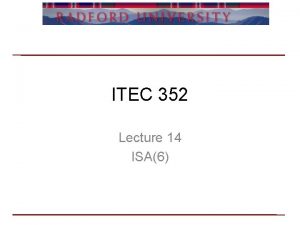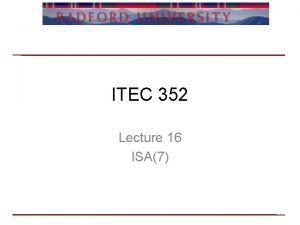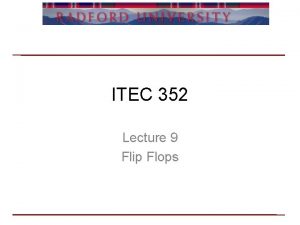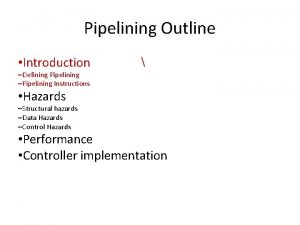ITEC 352 Lecture 22 Pipelining Review Questions Homework

















- Slides: 17

ITEC 352 Lecture 22 Pipelining

Review • • Questions? Homework 3 due next Wed. Control units for RISC Pipeline – Why? Problems? • Video Pipelining

Outline • Pipelining – Problems – Branching – Performance Pipelining

Example • Pipelining is not always efficient. Sometimes an instruction depends on its previous instruction’s results. – Implement the pipeline for the following: srl %r 3, %r 5 addcc %r 1, 10, %r 1 ld %r 1, %r 2 subcc %r 2, %r 4 • E. g. , CPUcycle Unit 1 Unit 2 Unit 3 Unit 4 Unit 5 Pipelining © Prem Uppuluri, Derived from Doug Comer

More problems • Another major problem: branch instructions. – E. g. , consider the following program snippet: addcc %r 1, %r 2, %r 3 be done srl %r 1, 10, %r 1 ba done 2 done: sll %r 1, 10, %r 1 done 2: halt. Can you see why the instructions cannot execute in 1 cpu cycle…draw the pipeline diagram Pipelining

Branches • Branch instructions thus cause the pipeline to be flushed. • Usually, after a branch a bunch of NOPs (no operations) are filled. • Similar problem with load (ld) and store (st). Since these instructions access the memory (which is slow to access), they need additional cycles (usually 1 additional cycle). Pipelining

Load/store • The extra cycles for load and store are called delayed loads/stores. • Any solutions to the branch problem? – Speculative branches. – One approach: load the next instruction after branch. If however, the branch fails, then undo the damage…. Pipelining

ILP: another issue. • ILP is great, because it is transparent to programmers…. – As a programmer you do not have to instruct the CPU to perform pipelining. • However, you could destroy the efficiency or get incorrect results …. This is called pipeline hazard • E. g. , consider the following two lines of code: inst 1: addcc %r 1, 10, %r 1 inst 2: ld %r 1, %r 2 Can you see any problems with these two instructions in a pipleline? Slide example taken verbatim from Doug Comer: Essentials of Computer Architecture Pipelining

ILP: another issue. • ILP is great, because it is transparent to programmers…. – As a programmer you do not have to instruct the CPU to perform pipelining. • However, you could destroy the efficiency or get incorrect results …. This is called pipeline hazard • E. g. , consider the following two lines of code: inst 1: addcc %r 1, 10, %r 1 inst 2: ld %r 1, %r 2 Problem: The second “ld” instruction uses operand r 1, which it will get only after the first instruction “addcc” is executed. Slide example taken verbatim from Doug Comer: Essentials of Computer Architecture Pipelining

Programmer consequences • Reorder instructions when necessary. • E. g. , C = A+B D = E-C F = G+H J = I-F M = K+L P = M-N • How will you reorder? Slide example taken verbatim from Doug Comer: Essentials of Computer Architecture Pipelining

Answer • Reorder instructions when necessary. • E. g. , C = A+B D = E-C F = G+H J = I-F M = K+L P = M-N • • • C = A+B F = G+H M = K+L D = E-C J = I-F P = M-N Slide example taken verbatim from Doug Comer: Essentials of Computer Architecture Pipelining

Pipeline efficiency • Efficiency of a pipeline is given by a value: CPIavg = average cycles per instruction. • Ideally, CPIavg = 1. Why? – We want to execute one instruction per one clock cycle. • What if a branch is taken? Pipelining

Branch • Let, – b : branch penality (i. e. , the number of cycles lost because of a branch). Usually this is 4 (4 cycles are lost). – Pb: probability of an instruction being a branch – CPInobranch = no branch taken. = 1 • Then, • CPI avg = (1 – Pb) (CPInobranch) + Pb(b) = 1 + b. Pt Example; probability a branch is taken: 0. 25, b = 4 What is CPIavg? Pipelining

Speculative pipelining • Let, – b : branch penality (i. e. , the number of cycles lost because of a branch). Usually this is 4 (4 cycles are lost). – Pb: probability of an instruction being a branch – Pt: probability that a branch is taken (when using speculative pipelining). – CPInobranch = no branch taken. = 1 • Then, • CPI avg = (1 – Pb) (CPInobranch) + Pb (Pt (CPInobranch ) + (1 -Pt ) b)) Example; probability a branch is taken: 0. 25, b = 4, Pt =. 5. What is CPIavg? Pipelining

Execution Efficiency • Any processors execution efficiency is given as the ratio of CPInobranch/CPI avg. Pipelining

Next … • We are done with Assembly. – Next: • Memory (Chapter 7) Pipelining

Review • Pipelining
 01:640:244 lecture notes - lecture 15: plat, idah, farad
01:640:244 lecture notes - lecture 15: plat, idah, farad Homework oh homework i hate you you stink
Homework oh homework i hate you you stink Homework oh homework i hate you you stink
Homework oh homework i hate you you stink Jack prelutsky homework oh homework
Jack prelutsky homework oh homework Homework oh homework jack prelutsky
Homework oh homework jack prelutsky Alitteration definition
Alitteration definition Grant always turns in his homework
Grant always turns in his homework One hot state assignment
One hot state assignment It 352
It 352 352 formação
352 formação Comp 352
Comp 352 Aci 352
Aci 352 Troop 352
Troop 352 Aae 352
Aae 352 Os 352
Os 352 Os 352
Os 352 Os 352
Os 352 Coen 352
Coen 352







